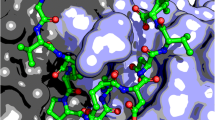Abstract
Positional knowledge of subunits within multiprotein assemblies is crucial for understanding their function. The topological analysis of protein complexes by electron microscopy has undergone impressive development, but analysis of the exact positioning of single subunits has lagged behind. Here we have developed a clonable ∼80-residue tag that, upon attachment to a target protein, can recruit a structurally prominent electron microscopy label in vitro. This tag is readily visible on single particles and becomes exceptionally distinct after image processing and classification. Thus, our method is applicable for the exact topological mapping of subunits in macromolecular complexes.



Similar content being viewed by others
References
Lührmann, R. & Stark, H. Structural mapping of spliceosomes by electron microscopy. Curr. Opin. Struct. Biol. 19, 96–102 (2009).
Ulbrich, C. et al. Mechanochemical removal of ribosome biogenesis factors from nascent 60S ribosomal subunits. Cell 138, 911–922 (2009).
Boisset, N. et al. Three-dimensional reconstruction of Androctonus australis hemocyanin labeled with a monoclonal Fab fragment. J. Struct. Biol. 115, 16–29 (1995).
Hainfeld, J.F. & Furuya, F.R. A 1.4-nm gold cluster covalently attached to antibodies improves immunolabeling. J. Histochem. Cytochem. 40, 177–184 (1992).
Stöffler-Meilicke, M. & Stöffler, G. Localization of ribosomal proteins on the surface of ribosomal subunits from Escherichia coli using immunoelectron microscopy. Methods Enzymol. 164, 503–520 (1988).
Stroupe, M.E., Xu, C., Goode, B.L. & Grigorieff, N. Actin filament labels for localizing protein components in large complexes viewed by electron microscopy. RNA 15, 244–248 (2009).
Wagenknecht, T., Berkowitz, J., Grassucci, R., Timerman, A.P. & Fleischer, S. Localization of calmodulin binding sites on the ryanodine receptor from skeletal muscle by electron microscopy. Biophys. J. 67, 2286–2295 (1994).
Stelter, P. et al. Molecular basis for the functional interaction of dynein light chain with the nuclear-pore complex. Nat. Cell Biol. 9, 788–796 (2007).
Liang, J., Jaffrey, S.R., Guo, W., Snyder, S.H. & Clardy, J. Structure of the PIN/LC8 dimer with a bound peptide. Nat. Struct. Biol. 6, 735–740 (1999).
Lutzmann, M., Kunze, R., Buerer, A., Aebi, U. & Hurt, E. Modular self-assembly of a Y-shaped multiprotein complex from seven nucleoporins. EMBO J. 21, 387–397 (2002).
Kampmann, M. & Blobel, G. Three-dimensional structure and flexibility of a membrane-coating module of the nuclear pore complex. Nat. Struct. Mol. Biol. 16, 782–788 (2009).
Nagy, V. et al. Structure of a trimeric nucleoporin complex reveals alternate oligomerization states. Proc. Natl. Acad. Sci. USA 106, 17693–17698 (2009).
Ludtke, S.J., Baldwin, P.R. & Chiu, W. EMAN: semiautomated software for high-resolution single-particle reconstructions. J. Struct. Biol. 128, 82–97 (1999).
van Heel, M., Harauz, G. & Orlova, E.V. A new generation of the IMAGIC image processing system. J. Struct. Biol. 116, 17–24 (1996).
Lutzmann, M. et al. Reconstitution of Nup157 and Nup145N into the Nup84 complex. J. Biol. Chem. 280, 18442–18451 (2005).
Acknowledgements
We thank P. Bork and C. Müller for providing the facilities for transmission electron microscopy at the EMBL Heidelberg and M. Lutzmann (Institute of Human Genetics) for creating the pET24d-NUP85–SEH1 and pPROEXHtb-GST-TEV-NUP145C–SEC13-T7-NUP120 expression plasmids. K.T. is a recipient of the Kekulé grant from Fonds der Chemischen Industrie. E.H. is a recipient of grants from the Deutsche Forschungsgemeinschaft (SFB 638/B2) and Fonds der Chemischen Industrie.
Author information
Authors and Affiliations
Contributions
D.F., P.S. and E.H. initiated the project; D.F., K.T. and P.S. designed and performed the experiments; B.B. contributed to electron microscopy image processing and discussion; E.H. supervised the project.
Corresponding author
Ethics declarations
Competing interests
The authors declare no competing financial interests.
Supplementary information
Supplementary Text and Figures
Supplementary Figure 1 (PDF 253 kb)
Rights and permissions
About this article
Cite this article
Flemming, D., Thierbach, K., Stelter, P. et al. Precise mapping of subunits in multiprotein complexes by a versatile electron microscopy label. Nat Struct Mol Biol 17, 775–778 (2010). https://doi.org/10.1038/nsmb.1811
Received:
Accepted:
Published:
Issue Date:
DOI: https://doi.org/10.1038/nsmb.1811
- Springer Nature America, Inc.
This article is cited by
-
Advances in domain and subunit localization technology for electron microscopy
Biophysical Reviews (2019)
-
Development of a yeast internal-subunit eGFP labeling strategy and its application in subunit identification in eukaryotic group II chaperonin TRiC/CCT
Scientific Reports (2018)
-
Architecture and subunit arrangement of the complete Saccharomyces cerevisiae COMPASS complex
Scientific Reports (2018)
-
Toward the atomic structure of the nuclear pore complex: when top down meets bottom up
Nature Structural & Molecular Biology (2016)
-
Structural basis of transfer between lipoproteins by cholesteryl ester transfer protein
Nature Chemical Biology (2012)





